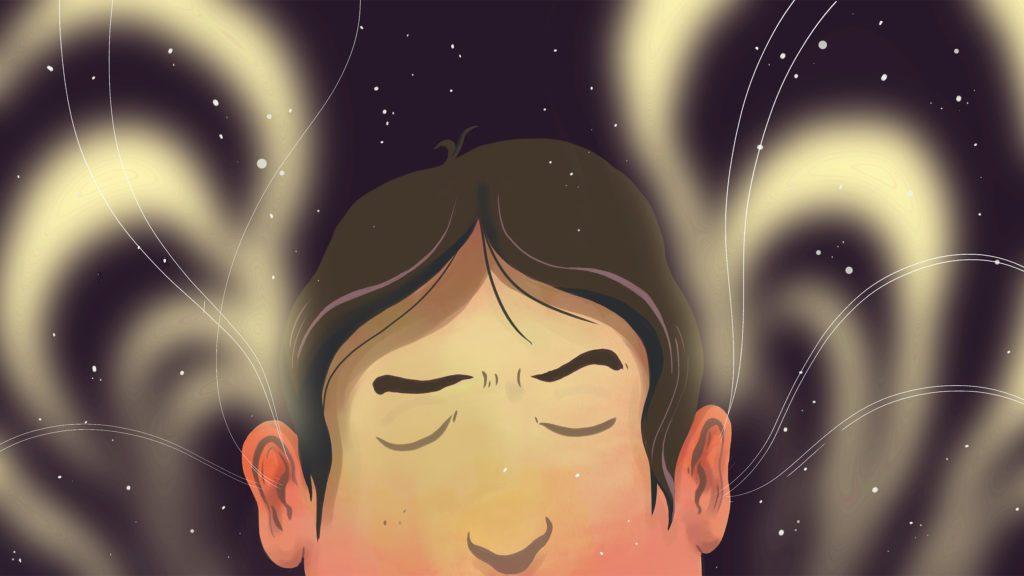This woman’s struggle to diagnose the ‘whooshing’ in her ears
Seven years ago, New York lawyer Emma Greenwood awoke to the beat of a pulse on one side of her head. The internet told her she had tinnitus, often called ringing in the ears. So did her doctor.
She knew that wasn’t right. When she listened to the “sounds of tinnitus” online, they reminded her of a whistling teakettle or squealing brakes. The sound dogging her days, by contrast, was a low-pitched rhythmic whoosh, pulsing in sync with her heartbeat.
It took a few months, but Greenwood finally found a doctor who understood what she was hearing and diagnosed her with a vascular condition. Her “whoosh” was,in medical terms, a “bruit” — the sound of turbulent blood flow through a narrowed vein in her brain.
Greenwood figured she couldn’t be alone: Many other patients hearing a whoosh had no doubt had been told they had tinnitus — for which there is no medical treatment. That’s a problem because whooshing can be treated — and sometimes, needs to be addressed quickly. The pulsing sound can indicate a condition that could lead to seizure, stroke, or death.
So Greenwood set out on a crusade to awaken the world to the whoosh.
She started a website, whooshers.com, with links to medical research and tips to help physicians understand the symptom. In a bid to raise awareness among the general public, she sells $25 “Do You Whoosh?” T-shirts, with the question mark shaped like an ear. Some patients have given the T-shirts to their doctors.
Greenwood, who also runs a Facebook support group, encourages patients to share their stories through social media on “Whoosher Wednesdays.” And she posts recordings of people’s whooshes, which are sometimes loud enough to be captured with a smartphone. They’re the most popular part of the site.
At the heart of her activism: A quest to get whooshing (the common name is “pulsatile tinnitus”) recognized as a symptom separate from tinnitus within the medical coding system. It often heralds a vascular condition, after all, not an auditory problem like tinnitus. The sound isn’t a ringing, but a swishing, pulsing, or thumping that is sometimes even described as a bird flapping its wings.
“Pulsatile tinnitus is not tinnitus,” Greenwood said. “It’s a travesty that the two share a name.”
Over four years, she collected more than 2,500 signatures on an online petition to get whooshing its own medical codes — and it finally happened. In the latest update to the codes, which took effect on Oct. 1, pulsatile tinnitus gets its own designation.
“Awareness is key,” Greenwood said. When her whoosh first struck, “I didn’t even know it had a name,” she said. “I recognize the desperation people feel.”
A rare condition
Pulsatile tinnitus is far less common than regular tinnitus, which afflicts around 20 percent of adults in the United States. Information is scant, but one small study found that 4 percent of patients reporting tinnitus actually had pulsatile tinnitus.
Doctors often overlook the symptom. When patients start noticing a noise in the ear, they usually consult first with an otolaryngologist, or ENT. They’re routinely, and mistakenly, told nothing can be done medically. That’s true for tinnitus. But not for pulsatile tinnitus.

“If these patients are taking advice from doctors who know nothing about the distinction, they are not going to get the help they need,” Greenwood said.
Greenwood, 41, urges fellow whooshers to get the appropriate diagnostic imaging — often including an MRI — and circulate the films to doctors who might help. Many cases are fixable, often by a catheter-based procedure and occasionally by surgery.
(It’s important to make sure you have pulsatile tinnitus before getting an MRI, however, because the noisy scan can be dangerously loud for patients with regular tinnitus.)
A proper diagnosis also helps for insurance purposes. “If you have vague or outdated codes, it is difficult for payers to figure out what they’re paying for,” said Sue Bowman, senior director of coding policy and compliance at the American Health Information Management Association. “This could lead to a request for more information or a denial of reimbursement.”
Greenwood’s efforts have “really impacted how pulsatile tinnitus is viewed,” said Dr. Maksim Shapiro, an interventional neuroradiologist at New York University Langone Medical Center, who treats patients with vascular abnormalities.
“Patients are oftentimes educating doctors, and it’s a legitimate education,” Shapiro said. “Pulsatile tinnitus is typically not a concern of the ear per se. The ear is doing what the ear is supposed to do — picking up sound.”
His department now hosts regular information sessions on whooshing.
The crusade continues
Sometimes the whoosh can be heard with a stethoscope placed on the skull. Another way to identify it, Shapiro said, is to have patients tap to the beat of the crescendo they’re hearing while he takes their pulse. The pulsatile beat is always in sync with the heartbeat. When patients exercise, their heartbeats will quicken. So will the pace of their whoosh.
Even if the underlying condition isn’t life-threatening, it can be intensely annoying. “If I do a procedure purely based on relief of the sound, I tell the patient it’s very legitimate to treat a sound that is so disturbing that it ruins the quality of life,” Shapiro said.
Greenwood opted not to have any procedure to address her whoosh. She said her own condition is tolerable.
But she’s not yet done with her crusade.
She would dearly love to get the condition renamed so it doesn’t include the term “tinnitus” at all.
The four new codes — for pulsatile tinnitus of the right ear, left ear, both ears, and unspecified ear — are categorized under “diseases of the ear and mastoid process.” Because the pulsing can indicate so many conditions, Greenwood would much rather see them listed under “not elsewhere classified” category.
“That word ‘ear’ just irks me,” she said.
This article is reproduced with permission from STAT. It was first published on Oct. 6, 2016. Find the original story here.



